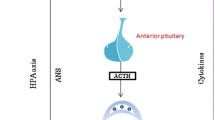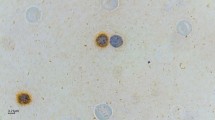Abstract
Non-human primates (Callithrix jacchus) were treated with 2,3,7,8-tetrachlorodibenzo-p-dioxin (TCDD) over a period of 30 weeks, and lymphocyte subpopulations of venous blood were monitored using monoclonal antibodies and flow cytometry (FACScan). There was no clear-cut change in the total lymphocyte population during this study. In the first part of the study the new-world monkeys (marmosets) were treated for 24 weeks with a weekly dose of 0.3 ng TCDD/kg body wt. At the end of this treatment period a level corresponding to an actual cumulative dose of about 2.5–2.7 ng TCDD/kg body wt was expected. The percentage and the absolute number of the CD4+CDw29+ cells (“helper inducer” or “memory” cells) surmounted the physiologically occurring increase. Concomitantly the percentage of the CD4+CD45RA+ cells (“suppressor-inducer” or “naive” cells) decreased. There was, at the same period, no change in the total T cell population (CD2+ cells) or in the cells carrying the CD8 or the CD4 epitope. When increasing the weekly dose to 1.5 ng TCDD/kg body wt, a transient increase in the percentage and the absolute number of the CD8+CD56+ cell population (“cytotoxic T cells”) was observed 3 weeks after the increase in dosing. At this time the expected decrease in the percentage or the absolute number of CD4+CDw29+ cells was just detectable and this decline was at its maximum 6 weeks after switching to the higher weekly doses. The reduction in the percentage and the absolute number of CD4+CDw29+ cells persisted 5 weeks after discontinuation of the dosing, but this cell population was again within normal limits 7 weeks later. Because the two subpopulations are changed in opposite directions, the ratio CD4+CDw29+/CD4+CD45RA+ is a very sensitive measure of the effect induced by TCDD. There was a pronounced decrease in the percentage of the CD20+ cells (B1 cells), but their percentage and number rapidly normalized, in contrast to the CD4+CDw29+ cells, when the dosing was discontinued. At the end of the treatment period the apparent body burden was calculated to correspondt an actual dose of about 9–10 ng TCDD/kg body wt. Such an actual dose level might be assumed to be reached under steady-state conditions in chronic experiments with daily doses of about 135 pg TCDD/kg body wt (assuming a half-life for TCDD in the marmoset of 6–8 weeks). Er trapolations of the results obtained at higher doses to very low exposures is not justified with respect to the effect induced by TCDD on the immune system of marmosets. A lower doses the effect is clearly reversed.
Similar content being viewed by others
Abbreviations
- TCDD:
-
2,3,7,8-tetrachlorodibenzo-p-dioxin
- MAB:
-
monoclonal antibody
References
Böyum A (1966) Isolation of mononuclear cells and granulocytes from human blood. Scand J Clin Lab Invest 21 [Suppl 97]: 77–89
Clark DA, Gauldie J, Szewczuk MR, Sweeney G (1981) Enhanced suppressor cell activity as a mechanism of immunosuppression by 2,3,7,8-tetrachlorodibenzo-p-dioxin. Proc Soc Exp Biol Med 168: 290–299
Clark DA, Sweeney G, Safe S, Hancock E, Kilburn DG, Gauldie J (1983) Cellular and genetic basis for suppression of cytotoxic T cell generation by haloaromatic hydrocarbons. Immunopharmacology 6: 143–153
Greenlee WF, Sutter TR (1991) Studies on the action of dioxin and related compounds on cell and molecular targets within the immune system. Naunyn-Schmiedeberg's Arch Pharmacol 344 [Suppl]: R33(S39)
Morimoto C, Letvin NL, Boyd AW, Hagan M, Brown HM, Kornacki MM, Schlossman SF (1985) The isolation and characterization of the human helper inducer T cell subset. J Immunol 134: 3763–3769
Neubert D, Wiesmüller T, Abraham K, Krowke R, Hagenmaier H (1990a) Persistence of various polychlorinated dibenzo-p-dioxins and dibenzofurans (PCDDs and PCDFs) in hepatic and adipose tissue of marmoset monkeys. Arch Toxicol 64: 431–442
Neubert R, Jacob-Müller U, Stahlmann R, Helge H, Neubert D (1990b) Polyhalogenated dibenzo-p-dioxins and dibenzofurans and the immune system. 1. Effects on peripheral lymphocyte subpopulations of a non-human primate (Callithrix jacchus) after treatment with 2,3,7,8-tetrachlorodibenzo-p-dioxin (TCDD). Arch Toxicol 64: 345–359
Neubert R, Jacob-Müller U, Helge H, Stahlmann R, Neubert D (1991a) Polyhalogenated dibenzo-p-dioxins and dibenzofurans and the immune system. 2. In vitro effects of 2,3,7,8-tetrachlorodibenzo-p- dioxin (TCDD) on lymphocytes of venous blood from man and a non-human primate (Callithrix jacchus). Arch Toxicol 65: 213–219
Neubert R, Golor G, Stahlmann R, Helge H, Neubert D (1991b) Dosedependent stimulative or inhibitory actions of TCDD on T-lymphocytes in peripheral blood of marmosets. Naunyn-Schmiedeberg's Arch Pharmacol 344 [Suppl]: R99(262)
Neubert R, Nogueira AC, Neubert D (1991c) Effects of 2,3,7,8-TCDD on the formation of activation markers in marmoset lymphocytes in vitro. Naunyn-Schmiedeberg's Arch Pharmacol 344 [Suppl]: R123(76)
Neubert R, Delgado I, Dudenhausen JW, Neubert D (1991d) Conversion of CD4+CDw29+CD45RA-lymphocytes of human cord blood to CD4+CDw29+CD45RA+ cells. Naunyn-Schmiedeberg's Arch Pharmacol 344 [Suppl]: R123(78)
Neubert R, Helge H, Stahlmann R, Neubert D (1991e) Einige Wirkungen von 2,3,7,8-Tetrachlorodibenzo-p-dioxin (T4CDD) und von 2,3,4,7,8-Pentachlorodibenzofuran (P5CDF) auf periphere Lymphozyten von Primaten in vivo und in vitro. Allergologie 14: 360–371
Pitot HC, Goldworthy TL, Moran S, Kennan W, Glauert HP, Maronpot RR, Campbell HA (1987) A method to quantitate the relative initiating and promoting potencies of hepatocarcinogenic agents in their dose-response relationship to alter hepatic foci. Carcinogenesis 8: 1491–1499
Rudd CE, Morimoto C, Wong LL, Schlossman SF (1987) The subdivision of the T4 (CD4) subset on the basis of the differential expression of L-C/T200 antigens. J Exp Med 166: 1758–1773
Salmon M, Kitas GD, Hill Gaston JS, Bacon PA (1988) Interleukin-2 production and response by helper T-cell subsets in man. Immunology 65: 81–85
Sanders ME, Makgoba MW, Shaw S (1988) Human naive and memory T cells: reinterpretation of helper-inducer and suppressor-inducer subsets. Immunology Today 9: 195–198
Sutter TR, Guzman K, Dold KM, Greenlee WF (1991) Targets for. dioxin: Genes for plasminogen activator inhibitor-2 and interleukin-1β. Science 254: 415–418
Author information
Authors and Affiliations
Rights and permissions
About this article
Cite this article
Neubert, R., Golor, G., Stahlmann, R. et al. Polyhalogenated dibenzo-p-dioxins and dibenzofurans and the immune system. 4. Effects of multiple-dose treatment with 2,3,7,8-tetrachlorodibenzo-p-dioxin (TCDD) on peripheral lymphocyte subpopulations of a non-human primate (Callithrix jacchus). Arch Toxicol 66, 250–259 (1992). https://doi.org/10.1007/BF02307170
Received:
Accepted:
Issue Date:
DOI: https://doi.org/10.1007/BF02307170




